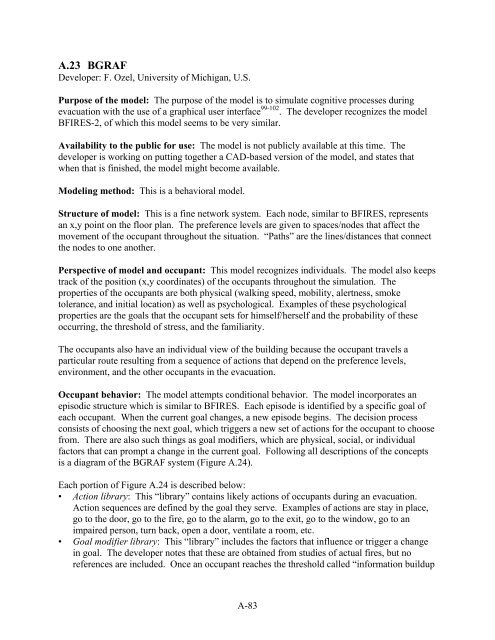A Review of Building Evacuation Models - NIST Virtual Library
A Review of Building Evacuation Models - NIST Virtual Library
A Review of Building Evacuation Models - NIST Virtual Library
You also want an ePaper? Increase the reach of your titles
YUMPU automatically turns print PDFs into web optimized ePapers that Google loves.
A.23 BGRAF<br />
Developer: F. Ozel, University <strong>of</strong> Michigan, U.S.<br />
Purpose <strong>of</strong> the model: The purpose <strong>of</strong> the model is to simulate cognitive processes during<br />
evacuation with the use <strong>of</strong> a graphical user interface 99-102 . The developer recognizes the model<br />
BFIRES-2, <strong>of</strong> which this model seems to be very similar.<br />
Availability to the public for use: The model is not publicly available at this time. The<br />
developer is working on putting together a CAD-based version <strong>of</strong> the model, and states that<br />
when that is finished, the model might become available.<br />
Modeling method: This is a behavioral model.<br />
Structure <strong>of</strong> model: This is a fine network system. Each node, similar to BFIRES, represents<br />
an x,y point on the floor plan. The preference levels are given to spaces/nodes that affect the<br />
movement <strong>of</strong> the occupant throughout the situation. “Paths” are the lines/distances that connect<br />
the nodes to one another.<br />
Perspective <strong>of</strong> model and occupant: This model recognizes individuals. The model also keeps<br />
track <strong>of</strong> the position (x,y coordinates) <strong>of</strong> the occupants throughout the simulation. The<br />
properties <strong>of</strong> the occupants are both physical (walking speed, mobility, alertness, smoke<br />
tolerance, and initial location) as well as psychological. Examples <strong>of</strong> these psychological<br />
properties are the goals that the occupant sets for himself/herself and the probability <strong>of</strong> these<br />
occurring, the threshold <strong>of</strong> stress, and the familiarity.<br />
The occupants also have an individual view <strong>of</strong> the building because the occupant travels a<br />
particular route resulting from a sequence <strong>of</strong> actions that depend on the preference levels,<br />
environment, and the other occupants in the evacuation.<br />
Occupant behavior: The model attempts conditional behavior. The model incorporates an<br />
episodic structure which is similar to BFIRES. Each episode is identified by a specific goal <strong>of</strong><br />
each occupant. When the current goal changes, a new episode begins. The decision process<br />
consists <strong>of</strong> choosing the next goal, which triggers a new set <strong>of</strong> actions for the occupant to choose<br />
from. There are also such things as goal modifiers, which are physical, social, or individual<br />
factors that can prompt a change in the current goal. Following all descriptions <strong>of</strong> the concepts<br />
is a diagram <strong>of</strong> the BGRAF system (Figure A.24).<br />
Each portion <strong>of</strong> Figure A.24 is described below:<br />
• Action library: This “library” contains likely actions <strong>of</strong> occupants during an evacuation.<br />
Action sequences are defined by the goal they serve. Examples <strong>of</strong> actions are stay in place,<br />
go to the door, go to the fire, go to the alarm, go to the exit, go to the window, go to an<br />
impaired person, turn back, open a door, ventilate a room, etc.<br />
• Goal modifier library: This “library” includes the factors that influence or trigger a change<br />
in goal. The developer notes that these are obtained from studies <strong>of</strong> actual fires, but no<br />
references are included. Once an occupant reaches the threshold called “information buildup<br />
A-83
















